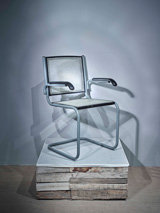STRUCTURAL FEATURES: Various models of the Godrej tubular chair are visible in offices, waiting rooms, reception areas and meeting halls across India. It was pioneered by Pirojsha Godrej in the mid-1930s along with other products such as steel cupboards, safe deposit vaults, steel windows and doors.
The tubular steel chair is first designed by Bauhaus designers Marcel Breuer and Ludwig Mies van der Rohe between 1925 and 1927 and represents a furniture idiom pioneered by them. Tubular steel, a fairly new material, was incorporated into furniture design for the first time. Breuer’s design was initially inspired by the tubular steel frame of a bicycle. In 1930-31, Thonet introduces Model B 32, Marcel Breuer’s first cantilevered tubular steel chair. It will have the most widespread influence of any chair of such style and form. Reproduced in 1962 by Gavina, it will then be known as the Cesca, a diminutive form of Francesca, the name of Breuer’s daughter.
The chair from Godrej combines hardwood and tubular steel, and is sturdy, durable and ergonomic.
STYLISTIC FEATURES: The chair does not have four legs; the tubular steel pipe is one continuous piece by itself, fashioned in a way so as to support it on the floor, while the spring effect of the cantilever enhances comfort.
Courtesy: Godrej Archives Collection



GODREJ TUBULAR CHAIR
DESIGNER: Unknown
MATERIAL: Stainless steel, Nylon weave
STYLISTIC INFLUENCE: Bauhaus
DESIGNER: Unknown
MATERIAL: Stainless steel, Nylon weave
STYLISTIC INFLUENCE: Bauhaus

